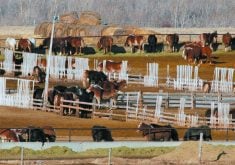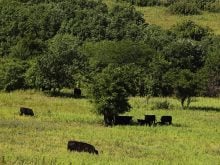Several areas in Western Canada are suffering from drought again this year.
Drought creates many difficulties for ranchers, who must struggle with the immediate and long-term problems that can arise from not having enough forage for their cattle.
I know some areas of the Prairies have received more adequate precipitation, but many ranchers are facing severe drought conditions and I can only imagine the stress it brings.
Drought affects the available summer pastures and the feed and forage options available for winter feeding.
Read Also

Canada told trade crisis solutions in its hands
Canadians and Canadian exporters need to accept that the old rules of trade are over, and open access to the U.S. market may also be over, says the chief financial correspondent for CTV News.
There are no magic solutions to the problems, but I suggest that feed testing should become even more important when drought occurs.
In many drought situations, the hay and forage crops are going to be impacted in terms of quantity and quality. It’s going to be important to get a handle on what quality you have available and how that can best be used in your herd during the winter feeding period.
In some cases, the quantity and quality may help you determine if you need to make tough decisions about culling cows or buying additional feed. It’s impossible to make those decisions without having an idea about the quality of feed that you have, especially in terms of energy and protein content.
You can’t afford to make a bad situation worse by allowing cows to drop too far in body condition. Declining body condition will have a huge impact on reproduction in the following breeding season and cause even more economic losses, as well as potentially causing an animal welfare situation through the winter if body condition is severely compromised.
In addition, we’ve seen that many producers will have to rely on alternative feed sources in winters following droughts. Sometimes, this may be cereal crops that are baled into green feed, or perhaps more reliance on straw-based diets, or other alternatives such as canola, lentils or peas.
You need to have some knowledge about the quality of these diets and the only way to do that is through feed testing. It will be important in straw-based diets to evaluate NDF, or neutral detergent fibre. NDF is usually included on all feed tests and measures the fibre component of the plant. NDF limits intake, especially in forages with levels greater than 70 percent. Sometimes, high NDF diets can cause impaction during winter feeding. For example, flax straw typically has very high NDF values and usually can only be fed at a maximum of 10 pounds per day.
Drought-stressed cereal crops can accumulate nitrates to a significant degree. Hail or frost damage can also cause plants to accumulate nitrate. Other crops that can accumulate nitrate include canola, flax, beet tops and sorghum. There are also a variety of weeds, such as Canada thistle and kochia, that could be classified as nitrate accumulators.
Rumen microbes convert nitrates to nitrite and finally convert it to ammonia, which is absorbed into the bloodstream and excreted in the urine as urea. However, if high levels of nitrates are fed to cattle, rumen bacteria can be overwhelmed and nitrites accumulate in the blood.
Nitrites alter the ability for hemoglobin in the bloodstream to carry oxygen and these cattle can basically go into oxygen deprivation with an increased heart rate, weakness, muscle tremors and difficulty walking. It can also cause down animals that are unable to rise.
There is some evidence that lower levels of nitrate toxicity can cause reduced productivity and also cause abortions or stillbirths in pregnant cows.
Feed testing is the best way to identify feeds that could be high in nitrates. This can be done most accurately at a feed testing laboratory. There is also a quick qualitative diagnostic test that can be carried out on the cut stem of plants, but it is best to send a representative feed sample to a diagnostic or feed-testing laboratory to get more accurate results.
Your veterinarian, nutritionist or local livestock extension specialist can help you interpret the results.
An overall nitrate level of greater than 0.5 percent should not be fed to animals unless precautions are taken.
Drought always creates significant challenges for our industry. Preventive strategies to ensure adequate nutrition are possible but often are logistically difficult and involve making tough decisions. Feed testing becomes even more important under these challenging circumstances.
John Campbell is a professor in the department of Large Animal Clinical Sciences at the University of Saskatchewan’s Western College of Veterinary Medicine.















